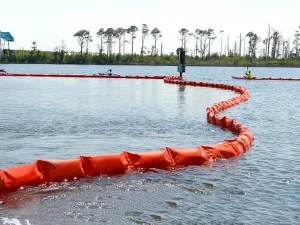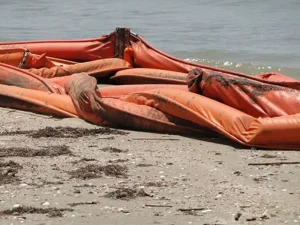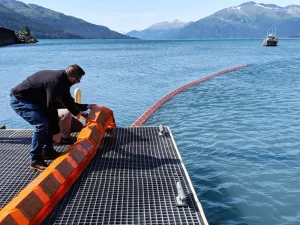Oil booms have become a must-use device in the marine world. They help prevent oil from contaminating water bodies, especially during spills and leaks. With them, keeping the rivers and oceans clean for aquatic life becomes easier. However, many don’t know: what are oil booms and how do they work?
Undoubtedly, oil booms have been in use for several years. However, their work is still a mystery to many people, especially those new to the marine world. Are you one of those without basic know-how of these oil booms? You’re in luck, as this article will discuss everything regarding the workings of oil booms. So, let’s get started!
What are Oil Booms?

Oil booms are tube-like structures that act as barriers, serving as a type of fence. They prevent oil from spreading when it is spilled in a water body. When an oil spill happens, you’ll see them employed as the first step. They restrict the spread of oil and help contain and collect it for its removal.
These floating barriers or tubes are employed in places where oil is spilled. They restrict the flow of the oil along with the water. They have multiple parts, which help them work effectively. However, a skirt and a freeboard are the most critical components. The skirt sinks deep into the water and remains suspended there.
It ensures the oil does not escape the barrier from underneath. On the other hand, the freeboard is the part that remains above the water’s surface. It ensures that no oil splashes and goes out of the barrier from the upper side. There are different types of oil booms. Each has its unique shape and way of working.
However, their primary purpose is to prevent the oil from spreading into the water body. Remember, oil booms have no role in removing oil from water bodies. They just stop the spread of oil and contain it in one place. Generally, when a leak occurs on a ship, the first action is to deploy oil booms.
The reason is that it helps keep the oil at one point. So it becomes easier to remove the oil. If there were no oil booms, the oil would have gone with water flow. So, it would have become impossible to remove that oil. Remember, if the oil remains in the water body, it affects the marine life present within it.
Components of Oil Booms

Understanding the workings of oil booms requires knowledge of the components that comprise them. Multiple components work in harmony to ensure the functionality of the oil booms. We have another article dedicated to oil boom components and their role. You should check it for a detailed explanation. For now, let’s have a brief look at them for a quick understanding:
- Skirt: It is part of the oil that booms inside the water body. Its purpose is to stop the spread or escape of oil underneath.
- Float: As you know, the oil booms stay on the surface. This part helps the oil booms float on the surface of the water body.
- Ballast: This additional weight keeps the skirt down in the water. Without ballast, the skirt won’t go inside the water body and float on the surface of the water body. Generally, steel-made chains are used as ballast.
- Freeboard: It is the part that remains on the water body’s surface. It does not go inside like a skirt. So, it stops the spread of low on the surface. Moreover, it prevents the spread of oil splashes and prevents them from escaping.
- Connectors: The oil booms are smaller in size. However, spills of oil sometimes occur in more areas. So, connectors are used to connect small booms to cover more areas. This way, the oil boom becomes large enough to contain oil spread over a large surface.
How Does Oil Boom Work? From A to Z
The working of the oil boom seems straightforward. All you need to do is employ these oil booms, and the job will be done. However, its working is based on multiple steps. Let’s discuss each of those steps that ensure proper working:
1- Detect the Oil Spill
The first step is to detect the access of oil spills in the water body. Remember, an oil spill can occur for multiple reasons. These include pipeline leaks, tanker accidents, or equipment failures. The team present on the platform first detected the oil spill visual. When oil spills, it remains on the water body’s surface and shines.
So, they detect it visually and report it to a higher authority. Then, the oil spill response team immediately reaches the location and assesses the extent of leakage. They know how long the oil has spread through their expertise and tools. Remember, the fast and quick detection of oil results in its easier removal, and vice versa.
2- Transport and Deploy the Oil Booms
It is key to note that oil booms are generally stored on shores, oil rigs, or coastal facilities. Once the oil detection and assessment are done, it is time to bring the oil to the affected areas. For this, the emergency response team or crews get orders and immediately work to transport the oil booms.
Generally, dedicated boats are used to bring the oil booms to the affected area. However, if the affected areas are too far from the shore, then aircraft can be used. Once the oil booms reach the affected area, the crew immediately deploys them. Generally, boats are used for deployment. It is done so that the oil booms surround the spilled oil.
This deployment is designed to prevent the oil from escaping above or underneath the boom. Workers can manually do this process if the affected area is smaller. However, if the oil spreads over a large area, boats are used to deploy these oil booms. If the oil spill happens in the middle of the ocean, dedicated anchors are used during the deployment process.
3- Booms Float and Form a Barrier
Once the oil booms are deployed, they spread and surround the spilled water. In this way, they create a physical barrier that prevents the oil from escaping. The freeboard of this oil boom is an important part that ensures the oil splash doesn’t go out from the top of the oil boom. Similarly, the skirt is part that goes deep inside the water.
The ballast (weight) on the skirt keeps it down. This way, the oil cannot escape underneath the oil boom. You might wonder if the oil may move away due to water waves. The answer is yes; the oil booms can sway slightly with the movement of water waves. However, they still maintain their physical barrier even while swaying.
As a result, the spilled oil cannot escape or spread. When the oil is contained at one point, the oil boom is anchored. During this, an anchor is thrown into the water. It keeps the oil booms steady at one point, allowing oils to be collected from a single point. The crew can also use towing of oil booms if the affected area is smaller.
4- Containment & Recovery of Oil
The anchoring of the towing process helped collect the oil at one point. As I said earlier, the oil booms act as physical barriers. So, they surround and keep the spilled oil at one point. Once the oil is collected, the recovery process begins.
Remember, spilled oil can be recovered and reused through dedicated machines. Tools such as oil skimmers, vacuum pumps, or absorbent materials are used for recovery. These materials absorb oil from the water’s surface. Their working is so smooth that they only absorb oil and do not take water.
The recovered oil can be repossessed and reused. Sometimes, oil spills happen in the middle of the ocean. Recovering oil from such places is relatively more challenging. Moreover, sending recovered oil from the middle of the sea to shore can be highly costly. Therefore, emergency response teams use the fire booms.
They collect the oil and then burn it to reduce its negative impact on aquatic life. As said earlier, spilled oil forms a layer. These layers prevent light and oxygen from entering the water. Therefore, aquatic life is significantly impacted. However, burning the oil saves the marine environment, including aquatic life.
5- Cleaning & Removal of Oil Booms
The last step is to remove the oil booms from the water body. This is the most crucial step; if done wrong, it can leave oil on the water body. How? When the oil boom creates a physical barrier, some oil comes on the surface of the oil booms. Therefore, this oil can be released back into the water body during the removal process.
Therefore, a careful approach is key when removing the oil booms. The emergency response team carefully removes the oil booms using boats. These used oil booms are then removed and washed to remove any contamination. An oil boom can stay in water for a few days and is generally discarded if it deteriorates. However, it is cleaned and stored for future use if it is still in reusable condition.
How Much Do Oil Booms Cost?
There is no fixed price for oil booms. They vary depending on different factors.
Generally, basic PVC-based oil booms are inexpensive, costing $6 to $15 per meter. Inflatable oil booms, known for quick deployment, cost around $12 to $20.36 per meter. However, heavy-duty oil booms used on a professional scale cost around $17 to $30 per meter.
However, these prices can vary depending on where you buy the oil booms. The cost of oil booms made in China is lower than those made in other countries. The reason is that Chinese manufacturers enjoy lower labor costs. So, they reduce the price to get market edges over competitors. Their prices vary depending on the type of oil material, size, and other parameters.
Some manufacturers are established and offer high-quality oil booms. So they sell their product at a higher cost and enjoy the brand. Conversely, some new manufacturers offer low prices in the oil boom. They do this to win customers’ trust and beat the market competition. Before purchasing an oil boom, it is essential to conduct thorough research.
How Long Does Oil Booms Last?

Generally, the oil boom can last between 2 and 7 years, depending on the type of oil boom. Remember, there are different types of oil booms. Each has its lifespan that can be enhanced by care. The oil boom, stored in good conditions and protected from UV rays, can last over 7 years.
PVC oil booms have a very short lifespan. On the flipside, the inflatable oil booms can last for several years. Some oil-absorbent oil booms are discarded after their first use. The life of the oil booms can be improved with proper care. You should protect them from direct sunlight, UV rays, and other environmental factors.
Conclusion
Oil booms have become a necessity for the marine environment. Whenever an oil spill is detected, the first action is to deploy the oil boom. They restrict the spread of the oil and collect it at one point. After that, removing the oil becomes easier with the use of skimmers and other tools. In this article, I discussed how oil booms work. Moreover, you’ll also learn about the pricing and overall lifespan of these booms.
